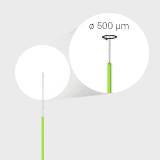For the past decade, the field of oncology has greatly evolved with non-invasive procedures such as ablation. There are a few types of ablation procedures used, but the most common is the radiofrequency ablation (RFA). RFA is a technique which uses light and heat to remove abnormal tissues and lesions. This type of ablation is used for hard and soft tissue surgeries. Some examples of these procedures include tumor removal, cardiac arrhythmias, venous and neurosurgeries. It can also be used in diagnostic medicine to perform biopsies. It is performed through persistent rapid pulses of radio frequency waves and heat. As the radio frequency waves and heat get closer to the most optimal conditions for a type of cell, the mortality rate of the tissue will increase. The equipment that is used in radio frequency ablation is a radio frequency generator with needle electrodes.
While RFA is a safe approach for the treatment of cancers, the use of radio frequency waves causes an excessive amount of heating which results in protein denaturation and radiation burns leading to decreased function in the body. In some severe cases, it may also lead to excessive bleeding, damage to surrounding blood vessels, and irreversible neurological damage. Additionally, the temperatures used in RFA could cause tissue necrosis (death of cells in the tissue) within surrounding tissue unless the temperature is carefully monitored, leading to the halt of radio frequency current when the clinical endpoint is reached. This shows that temperature distribution is important to protect surrounding healthy tissues
The sensors used today are broadly categorized as invasive or contact and non-invasive or non- contact. Non- invasive methods use Ultrasound imaging, Computed Tomography (CT) or Magnetic Resonance (MR). Although these methods provide advance image-based temperatures maps, the results are not real time and are not compatible with all devices. Invasive sensors like thermocouples, require it to be inserted directly into the target tissue to measure the temperature. While they are cost-effective than imaging system, there is significant measurement error that needs to be offset. Additionally, thermocouples are slow to respond to the rapid temperature changes found in RF ablation therapy.
Click here to learn more about RFA Ablation Solution.
Fiber optic sensors (FOS) are the state-of-the-art invasive sensors extensively used today in the RF ablation procedures. There are different FOS technologies available, like Fiber Bragg Grating (FBG), however Fiber Point Sensors are extensively used for temperature measurement. These sensors are small (200- 500 µm) for easy integration into existing medical equipment with wide temperature measurement range (greater than +/-100 C).
 Specifically, in ablation procedures, they can help monitor the specific varying temperatures required to target certain malignant cells. This is essential because each type of cell has certain specifications to induce apoptosis-programmed cell death. These specifications include temperature and the persistence of pulses used. Additionally, for each type and size of tumor, specific temperatures must be used to increase the mortality rate and decrease the recurrence rate of such tumors.
Specifically, in ablation procedures, they can help monitor the specific varying temperatures required to target certain malignant cells. This is essential because each type of cell has certain specifications to induce apoptosis-programmed cell death. These specifications include temperature and the persistence of pulses used. Additionally, for each type and size of tumor, specific temperatures must be used to increase the mortality rate and decrease the recurrence rate of such tumors.
The fibers are also biosafe and chemically inert. This allows for drugs and chemicals used in treatments to not be altered to accommodate fiber monitoring. They also respond to rapid changes in the local environment, which is about 30ms without compromising on the accuracy of the reading ( +/ 0.2 C).These advantages makes them highly coveted in RF ablation therapy and increases the effectiveness of treatment for patients.
The trend towards minimally invasive surgery is increasing, which requires variety of minimally invasive medical devices with safe, precise monitoring for successful treatment. FOS is an ideal fit with capabilities and features that cannot be otherwise obtained using thermocouples. The FOS sensor design and development are not trivial, and proper material selection, design, biocompatibility, patient safety, and other issues must be considered.
Rugged Monitoring (RM) has deep expertise in the medical FOS technology and developed the LSENSB sensor tailored for this application. LSENSB sensor was designed for advance research applications that demand high sampling rate( ~30ms). There are several variants of LSENSB sensors already in the market used by research institutions, surgeons, and equipment manufacturers. RM is a pioneer in making custom fibers that would easily integrate into existing equipment.
1. Wikipedia